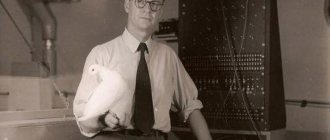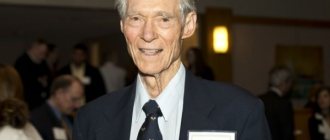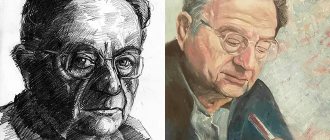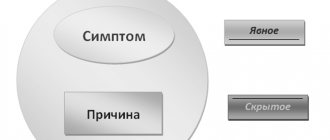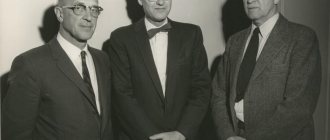Kurt Lewin: biography
The future psychologist was born on September 2, 1890 in the city of Mogilno, which was located on the territory of the Prussian province of Posen (today it is the territory of Poland). At birth the boy was named Tzadek. But such a name in Prussia did not bode well. For this reason, the boy was given a middle name - Kurt.
The young man could hardly hope for a happy future in a remote province. However, in 1905 his family left their hometown and moved to Berlin. Kurt enters the Faculty of Medicine at the University of Freiburg and attends lectures in biology at the University of Munich.
Scientific activity
With the outbreak of World War I, Levin served in the German army. There he made his first discovery. The future scientist found out that a person’s worldview completely depends on the group and environment with which he is associated. Thus, the researcher knew from his own example that soldiers may consider a dirty ditch as a suitable shelter, and a flat, flowering lawn as the territory of death. Thus, Levin was able to prove that the perception of the world around the front-line soldiers differs from the thinking of people in peacetime. Moreover, changes in consciousness occurred among all representatives of the same community.
Levin Kurt, who was wounded during his service, was demobilized, which prompted him to continue working on his dissertation at the University of Berlin.
Initially, Lewin delved into behavioral psychology. But over time, his research somewhat changed its direction towards Gestalt psychology. This made it possible to work with such representatives of this school as Max Wertheimer and Wolfgang Köhler.
In 1933, Levin Kurt went to England, from where he soon moved to the USA. At the same time, the scientist met with Eric Trist, who was impressed by Kurt's research while serving in the army.
Prior to this, Levin served as a professor at Stanford for six months, after which he went to Cornell University. Kurt was soon appointed director of the Center for Group Dynamics at the Massachusetts Institute of Technology.
1946 became a fateful year for Levin. He received a request to find a method that could overcome religious and racial prejudices. Kurt undertook an experiment that would later become known as “group psychotherapy.” Such achievements were an important element in the founding of the National Training Laboratory.
After the end of World War II, Kurt was involved in the psychological rehabilitation of former concentration camp prisoners.
Kurt Lewin died on February 12, 1947 in Massachusetts. An outstanding scientist was buried in his homeland. His death occurred quickly after the opening of a center for retraining world leaders. Unfortunately, Kurt did not live to see his dream come true.
Personal life
In 1917, Maria Landsberg became Kurt Lewin's wife. In 1919, they had a daughter, Esther Agnes, and in 1922, a son, Fritz Raven. In the second half of the 1920s, their personal life began to fall apart at the seams. The couple divorced in 1927, and Landsberg decided to immigrate to Palestine with her children.
Kurt Lewin did not long for female care for long. Already in 1929, he married Gertuda Weiss, who bore him two children: in 1931, daughter Miriam was born, and in 1933, son Daniel. His wife survived Levin by 40 years and died in 1987.
Prerequisites for the discovery of “Field Theory”
The formation of field theory was influenced by the achievements of the exact sciences, in particular physics and mathematics. At the same time, Levin was fascinated by psychology, into which he also sought to bring some precision. Thus, Lewin's main discovery in the post-war period was a psychological experiment. Until this time, it was generally accepted that psychology was completely incompatible with this concept, because this science is based on such substances as the soul, emotions, and character. In short, it was believed that psychology is closely related to what cannot be studied under a microscope.
Kurt Lewin's field theory (briefly)
However, Levin went in the opposite direction, using hidden camera tricks. During his experiments, the scientist placed the subject in a room where there were various objects: a book, a bell, a pencil, and the like. Each person began to perform some manipulations with things. But ringing the bell was typical for everyone.
Kurt Lewin's experiments led him to the conclusion that a person without a specific goal is influenced by external factors. All subjects were characterized by actions to which they were, as it were, pushed by the objects themselves. It followed from this that people knocked out of their usual environment were quite easy to manage. After all, not a single participant in the experiment had to take a pencil or ring a bell. Thus, the objects influenced the person’s needs, which the psychologist interpreted as certain energy charges that provoked tension in the subject. This state pushed a person to release, which consisted of satisfying needs.
Thus, Kurt Lewin's field theory, a summary of which is presented to your attention in the article, became an original interpretation of human behavior. Thanks to it, it was proven that the set of actions completely depends on the specific conditions of the existing field.
Relevant Variables
As with an energy field, every part affects every other part. To understand our behavior, we must remember all the variables that play a role in it in real time. This is true at both the individual and group levels.
We also cannot analyze these elements individually. Therefore, we must focus on studying how they interact to get a complete picture of what exactly is going on. Lewin proposed three key variables to explain this idea.
- Energy: what causes actions, what motivates them. When there is a need, energy or an energetic field will lead to action. All these actions have a charge, positive or negative. The charge of these actions also leads to other actions (positive) or pushes them back (negative). The behavior that comes from all of this reacts to a psychological mixture of different energies.
- Tension: The difference between a person's goals and their current state. The tension is internal and pushes you to go through your intentions.
- Necessity : what gives motivational tension to begin with. When a person has a physical or psychological need, an internal state of tension awakens within him. This state of tension forces the system (the person) to change in order to try to return to its original state and satisfy its needs.
Lewin says that field theory shows what the possible and impossible forms of behavior of each person are. Awareness of living space helps us make a logical prediction about what a person will do. Every single behavior, or at least every intentional behavior, has a motivation. There are tensions pushing it, energies moving it, charges directing it, and it all has a purpose.
Specifics of the teachings of Levin Kurt
The psychological study of human behavior has been reduced to a number of features:
- Behavior must be analyzed within the framework of the overall situation.
- An individual person in an individual situation is represented mathematically.
- Behavior is shaped only by real events. What happened in the past or will happen in the future only slightly changes the composition of the field.
- Seemingly identical behavior is not always provoked by the same reasons.
Scientists introduced the concept of “generic identity”. Kurt Lewin, whose photo you see in the article, believed that an individual’s behavior cannot be determined by a person’s character or his upbringing. However, both of these natures are very significant. It follows from this that behavior is the result of the interaction between the individual and the situation.
World War I period
When World War I began, the young scientist joined the ranks of the infantry division. It was his passion for psychology that helped Kurt Lewin survive the difficult period of trench life. When others risked their lives and suffered military hardships, Kurt was also engaged in scientific activities at the front: he observed his fellow soldiers, questioned them, and analyzed the facts. The soldiers had no idea that for the scientist they were not just comrades, but also material for scientific research.
What conclusions did Kurt Lewin draw? Psychology, or rather observations of the psychology of front-line soldiers, gave him the idea that soldiers at the front perceive the environment differently than civilians. A dirty ditch, for example, in war is perceived as a good shelter, and a clearing, which would be perfect for a picnic, is seen by soldiers as a dangerous zone, because in such an open area they can easily be overtaken by a bullet.
The main conclusion was that in this way the perception of reality changed not among one or a few people, but among a fairly large group of front-line soldiers.
Kurt Lewin formulated this idea this way: “It is usually easier to change individuals in a group than to change each of them individually.”
The famous scientist Eric Trist was so impressed by Lewin's theory that he subsequently used it during World War II in his own research.
Basic management methods
Levin Kurt, among other things, studied organizational methods of management in groups. According to the scientist, they can be classified based on their leadership style. There are these basic styles:
- Authoritarian. The person feels hostile due to strong pressure from the group leader.
- The democratic style is about joint development of strategy based on collective processes, taking into account the opinion of the leader.
- Complete non-interference. The essence of this style is that all decisions are made without the participation of the leader. He participates in the division of labor only if he is asked to do so. Such a leader very rarely praises anyone.
Environment model
The environment is a living space where a person comes into contact with other living and inanimate objects, adapts to events and surroundings. Any person interprets any real objects. As you know, human perception is based on projection, that is, on looking at an object under the refracted ray of one’s own experience.
No matter how strange it may sound, everyone has their own reality, it depends on perception. It is impossible to meet two people with absolutely the same view of things, since the world is a stage of individual projections.
Moreover, the environment shapes the personality. A person born on the sultry shores of Africa will have one way of thinking, a person from the Saratov region of Russia will have another. But if a Russian moves to Africa, he will change in any case and become a different person, with different needs, this is inevitable. The environment will determine the content of the human psyche and fill it. A person cannot be “on his own.”
In his model of personality, Kurt Lewin identified a special sensorimotor zone located outside, and the needs of this personality are located inside it.
Thus, the sensorimotor zone has two sides: external and internal.
The first side of the sensorimotor zone is the external one, in other words, the border where the person interacts with other people. In fact, when communicating with a person, you see only this shell; you cannot know about the rest.
If we see a person eating a hamburger with appetite, we think that he is hungry. But in fact, he is in extreme anxiety or fear and eats them up. This example shows that a person can satisfy a completely different need, not hunger, but we can never see what a person really wants. As Martin Heidegger said:
We will never know what another person is like.
The second side of the sensorimotor zone - the internal one - is the zone of awareness, where a person knows what he wants by certain physical sensations, where he “feels his feelings”
It is very important that this boundary is maintained. After all, then a person is clearly aware of his real needs
Activities of Kurt Lewin at the research center
In 1944, Kurt Lewin managed to found the Center for the Study of Group Dynamics at the Massachusetts Institute of Technology. At the same time, he pursued purely altruistic goals. All his life the scientist hoped for the establishment of humanism in the world. In his opinion, all humanity needs democracy in order to soften its morals. Kurt Lewin tried to help the development of humanism through group trainings.
The scientist is convinced that for change a social group needs to go through several stages:
- "defrosting";
- "change";
- "new frost"
“Unfreezing” is a situation when a group is deprived of its usual life and value priorities. During such a period, she is completely at a loss. At the next stage, she is offered a new value and motivational system, after which the state of the group should be “frozen” again.
By the way, it was Levin who created a new type of communication between a psychologist and his client. Often such communication is more like a conversation between a doctor and a patient. Kurt completely changed the communication strategy. His communication was similar to a dialogue between students and a professor.
Motives
Kurt Lewin said that you can explain all your actions by one simple fact: we see specific ways and means to relieve certain tensions.
Kurt believed that such actions should have a positive charge. That's why you feel the energy forcing you to do them. And then other actions should have the opposite effect. They will increase your tension and therefore they should have a repellent effect.
To understand all this better, here is an example of a need we all have: the need for recognition. When you begin to feel this need, it awakens the motivation to gain recognition in the field that interests you. This motivation will have a positive charge and will lead you to take action to gain recognition.
Motivation will awaken the tension between your current situation and your need for recognition. Then it will force you to think about possible actions to get this recognition. And depending on what area you want to be recognized in, you will do whatever you think will give you the best chance of getting it.
Experiments by psychologist Kurt Lewin
The research center, created by Kurt Lewin, actively conducted training for employees of various enterprises. For example, the Harwood Manufacturing Company turned to the services of a psychologist with a complaint that when introducing any innovations, the company’s employees take a very long time to train, which leads to a drop in productivity levels.
To solve the problem, Levin Kurt took three groups of employees and gave them tasks:
- The first group decided how to work most efficiently within the new technical process.
- The second group had to select several representatives who would be sent to management to discuss innovations.
- The third group, consisting of workers and managers, was supposed to brainstorm how to master the new technology.
As a result of the experiment, it turned out that the best results were demonstrated by the last group. After this, the company's management received recommendations from an outstanding psychologist.
Needs and how we implement them
A person's needs determine his behavior. A person can say and think whatever he wants about himself, but he will automatically act based on his needs. In Kurt Lewin's scheme, needs are located within the outer boundary; they can be represented in the form of “circles” that fill a person’s energy. For example, a need is the need to find a loved one. An individual may even deny this, but will act by inertia - travel in search of new people, watch films about love, “casually” discuss it.
A personality is a complex system, all life activity of which strives for balance. When the balance is disturbed (and it is disturbed all the time, and this is the norm), tension arises inside.
It is worth saying that needs do not exist initially; they appear as a result of contact with the environment. A person living in a Vologda village in the family of a farmer and living in the center of Berlin surrounded by rock musicians will have different needs.
A huge information flow, especially advertising, creates so many needs in a person that an excess of them accumulates. This overloads the human psyche and gives rise to anxiety of an incomprehensible origin. For example, if you think about it, everything we buy or dream of buying is completely unnecessary. For example, in gadgets we use no more than 25% of the functions, although we change them every six months for updates.

